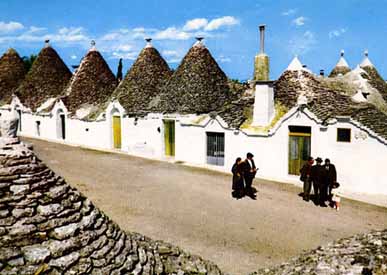| I Love
You, Trulli.
By Jeanne
Manfred
"Toto, I don't think we're in Kansas anymore..."
 Inland from the city of Bari, on the road to Alberobello,
tiny white stone houses topped with gray slate, cone-shaped roofs begin
to dot the countryside. As more and more small clusters of these little
houses appear on each side of the road, you begin to wonder, "Am I still
in Italy? Have I been magically transported into some fairy tale country?"
Then, after arriving in Alberobello, smack in the middle of a whole
village of these strange little "trulli", suddenly you know. You've
discovered the Land of Oz. It's MUNCHKINLAND! Inland from the city of Bari, on the road to Alberobello,
tiny white stone houses topped with gray slate, cone-shaped roofs begin
to dot the countryside. As more and more small clusters of these little
houses appear on each side of the road, you begin to wonder, "Am I still
in Italy? Have I been magically transported into some fairy tale country?"
Then, after arriving in Alberobello, smack in the middle of a whole
village of these strange little "trulli", suddenly you know. You've
discovered the Land of Oz. It's MUNCHKINLAND!
A "trullo"
(two or more make "trulli"), built out of the plentiful local stones,
is a rectangle outside, an oval inside and a triangle on top. The lower
edges of the steep cone roofs come down to meet all the different heights
of the walls and the peak above the little front door, making the whole
structure look as quaint as an English thatched cottage or as cute as
a gingerbread house.
Seldom
do you see just one lonely "trullo" by itself, for as a family grows
so does their tiny one room house. A new "trullo" is nestled right up
beside the first one, naturally, with an opening made in their common
wall to connect the two. Later, if the family wants even more
room, it's simple, just add another one, then another, each with its
very own pointy headed roof. Some have also added lofts under
their roofs. And, a few very fancy ones are even two-story, such as
the most famous one in Alberobello, built in 1780. It's called Il
Trullo Sovrano, making it truly one prince of a place.
Actually
Alberobello looks like two different towns. On one slope is the standard
pleasant Italian village. On the other slope it is all "trulli", hundreds
and hundreds of them climbing up and down the picturesque little narrow
walking streets. It's almost a surprise to see that the men and women
who live and work there are regular size folk and not Munchkins, the
"little people", after all. For, without being cutesy, it is all
just plain adorable --and fun.
Some trulli
have been turned into small shops for the tourist trade. So, as you
stroll around among the little houses, you find a few of the usual souvenir
shops, but most display the handicrafts of the local artisans.
Others offer the wines, jams and other tempting foodstuffs that are
specialties of the region.
At the
top of the hill, there is a sprawling trulli hotel where the
night can be spent in your own private trullo. However, since
meals are included in the price, it is a bit pricey. Much better bargains
can be found in one of small hotels in the standard Italian part of
town, within easy walking distance to and from the trulli section.
Where did
this unique style of architecture come from? A good guess is that
the name trullo comes from the Greek tholos, the name
for a conical-shaped, domed tomb, such as those earliest ones found
at Mycenae, (i.e., Agammemnon's tomb) and in Crete, dating from the
early Bronze Age. Similar domed tombs of later eras are to be
found all through the Mediterranean world, including Southern Italy.
However,
even earlier, perhaps around 3000 BC, peoples from the Mid-East, looking
for a more fertile land, migrated westward. Some of these wanderers
finally settled down in what is now La Puglia, bringing with them their
primitive culture. The native stones lying about all over the fields,
ready to be easily picked up, were first used to build their tombs.
Eventually, as this method of construction evolved, they also began
to build primitive domed dwellings, with empty spaces inside to shelter
them during bad weather --the forerunner of our cozy family home, without
the monthly rent or the 30 year mortgage.
These prehistoric
colonists also brought along their magic symbols, which are still being
used as special designs of white stone set into the roof of a trullo.
Later, Greek and Christian symbols, such as the cross, were added to
the ancient ones. However, even today, many of the doors face east,
toward that first god of all, the Sun.
The Pinnacoli
or "Pinnacle", the knob-like balls at the very top of all the trulli,
are also throwbacks to the ancient worship of the Sun god. All
through the ages, such religious symbols have been placed at the apex
of a house, a temple or a church to represent the union between a people
and their gods.
Much of
the region of La Puglia is full of undiscovered treasures --at least,
undiscovered by most American and English tourists. For instance, just
a short distance from Alberobello is one of the great natural wonders
of Italy, the Caverns of Castellana (Le Grotte di Castellana).
These are tremendous underground caves with spectacularly beautiful
rock formations, plus stalactites and stalagmites that abound in a fantasy
of colors.
Going from
"Munchkinland" to "Fantasyland" sound more like a trip to Disneyland,
but it's really even better. It's REAL. Trulli it is!
back
to main page |
